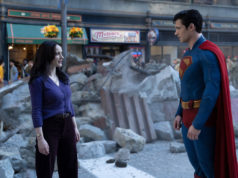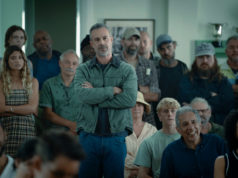
I read all three of Suzanne Collins’ Hunger Games novels in the space of a week last year, so you won’t be surprised to learn that I have many more thoughts than I was able to get into my review of the movie.
I mentioned being disappointed that the movie doesn’t play up the books’ commentary on reality TV. Like reality show producers, the gamemakers introduce new elements and change the rules arbitrarily to manipulate the proceedings. Like reality show contestants who need audience votes to stay on, the Hunger Games competitors have to make the audience relate to them, at the very least, because doing so can win them sponsors, wealthy viewers who pay to send a competitor food, medicine, weapons, or gear during the games. In this tournament, public relations skills can save your life as much as being able to handle a sword. Stephen Burt’s blog post on Slate really teases out the parallels; in fact, it might be the best thing I’ve read about the Collins’ books. To a lesser extent, so does Peter Bradshaw’s review in The Guardian, though he also brings up a movie that I must confess I had forgotten about entirely: Daniel Minahan’s Series 7: The Contenders, which came out in 2001 when reality television was still a novelty. That film has adults hunting each other down and murdering each other in a present-day city for the entertainment of a TV audience. The movie’s worth checking out if you can find it.
In reviewing the film, a lot of people refer to Kinji Fukasaku’s 2000 Japanese film Battle Royale, which (what are the odds?) came out just last week on DVD. It’s also about children forced to kill other children. In years past, I heard the movie mentioned in reverential tones among my J-culture-geek friends. Evidently Quentin Tarantino was a fan; he cast Chiaki Kuriyama (who played one of Battle Royale’s killer kids) as the giggling Japanese schoolgirl killer in Kill Bill Vol. 1. I finally caught up with Fukasaku’s film last week before I saw The Hunger Games. Maybe there was no chance that the Japanese movie would live up to everything I heard, but I found it somewhat dated. The elements that undoubtedly made it seem extreme in the early ’00s now look denatured, and Battle Royale doesn’t have nearly as sophisticated a social critique as The Hunger Games.
I read the novel after Jennifer Lawrence had already been cast in the movie, but before the other actors had been. All through it, I couldn’t help but think, “This is the same character she plays in Winter’s Bone.” Indeed, there’s no shortage of other people who’ve noticed the similarities. Like Katniss, Ree Dolly has had to take over the parenting of her younger siblings because her father is gone (missing, as opposed to killed in a coal mine) and her mother is mentally ill. (Katniss’ mother is functional, but has suffered from severe depression.) Also like Katniss, Ree hunts small game (squirrels, precisely) to keep the family eating. Because Winter’s Bone is a realistic film set in present-day America, Lawrence’s performance there is much rougher than it is in this fantasy-adventure film. Watching Winter’s Bone, you can easily see why the filmmakers of The Hunger Games decided to cast her. Lawrence aside, I’m not that high on the performances by the talented cast here. Josh Hutcherson’s big contribution is in the early scenes just after Peeta has been picked for the tournament, where he wanders around in a “What the hell is happening to me?” daze. The one supporting actor who jumps out at me is Isabelle Fuhrman as Clove, the knife-throwing girl from District 2. She’s the only contestant I look at and think, “That’s a born killer.”
I mentioned at the top of my review that the book is a great food novel — not for nothing is it called The Hunger Games. As the book’s narrator, Katniss continually describes the food that she comes in contact with. Her family has been through a period of near-starvation before the story begins, and though they now have just enough to eat, she has learned to keep careful tabs on just how much food they have, and how to stretch their existing supply. When she volunteers for the Games, she’s whisked off to the Capitol and is given the chance to eat a lot of exotic foods that she’s only heard about, such as oranges and chocolate. Then when the Games begin, her food supply is again limited, so she has no choice but to obsess over what is available. The food blogs have picked up on the hype surrounding the film. You can find reconstructed recipes for the Capitol dishes Katniss encounters, or recipes simply inspired by the novels.
Two major founts of Hunger Games think pieces are Slate and io9. The former has articles speculating on the economy of Panem and the workings of the lottery system for choosing tributes. The latter has a map of Panem and links to fan-created Hunger Games propaganda like the delightful World War II-style poster above this post. Strangely, the Internet hasn’t offered up much in the way of fake video propaganda, which you expect would exist in Panem because the government controls the TV broadcasts. The trilogy’s maligned final installment, Mockingjay, deals more with the government-controlled media. Perhaps the filmmakers will make some of their own Panem propaganda when they get to the series’ end. (By contrast, the movie’s website has an offshoot site called Capitol Couture that parodies the Capitol’s fashion-crazy celebrity culture. This is great, even if the Internet doesn’t exist in the Hunger Games’ universe.) Elsewhere, the New York Times’ profile of Collins argues that the books are actually war novels, while Overthinking It digs deep into economic theory while discussing Panem’s social setup, and Television Without Pity speculates on who might play the roles in future installments. Oh, and Gossip Girl actor Penn Badgley thinks the series is about the Occupy movement.
Slate also points out the Roman names of the Capitol’s citizens. The movie takes the Roman parallel a step further when revealing the ultimate fate of the gamemaker Seneca Crane (Wes Bentley). It’s a scene that’s not in the book, and it elegantly parallels the fate of the historical Seneca the Younger. Of course, Panem’s name itself comes from Juvenal’s statement about the Roman public caring for entertainment more than public life. Speaking of Seneca Crane, the movie has two scenes that take place between him and President Snow (Donald Sutherland), without Katniss present. This is a departure from the books, where everything is narrated from Katniss’ point of view. The president makes a nice point about how the Games pacify the people by giving them hope as well as terrorizing them. The meticulously sculpted beard on Bentley’s Crane has itself become an Internet meme, and no wonder. It’s the one detail in the production design that really pops. Capitol Couture features an interview with Crane’s beard sculptor. I always wanted to be a beard sculptor.
I’ll leave you with a couple of web parodies. The Muppets have chipped in with theirs, but the funniest parody video I’ve seen is this one on College Humor that imagines the novel turned into a super-girly board game. Happy Hunger Games, everyone!












Actually, there is some Panem government propaganda in the movie, in the form of a short film shown to the children of District 12 before the Reaping. I forgot about it because it’s boring (and designed to be that way).